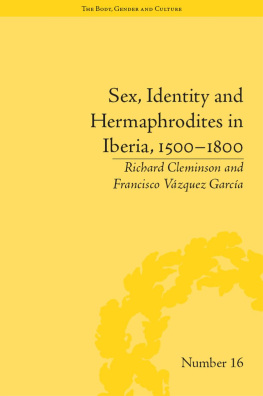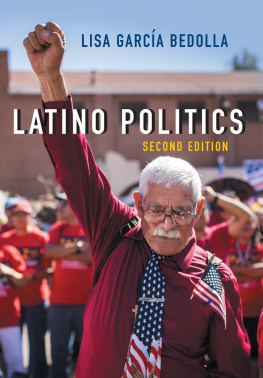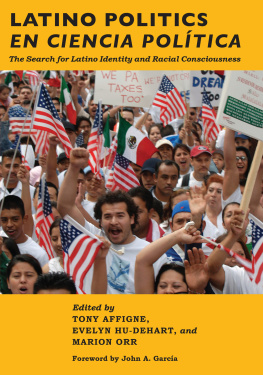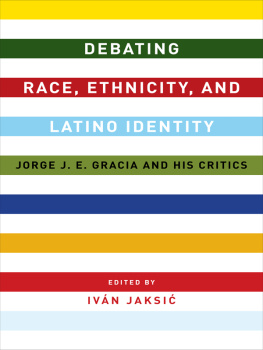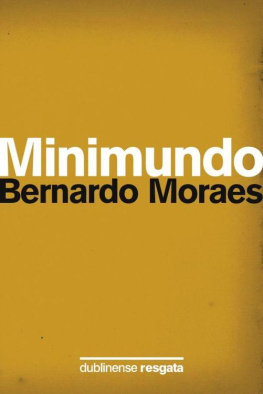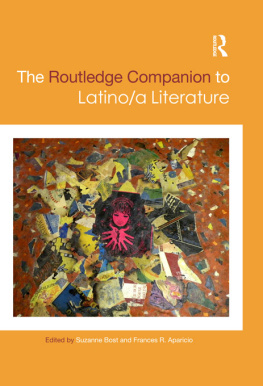First published 1998 by Garland Publishing, Inc
This edition published 2013 by Routledge
Taylor & Francis
711 Third Avenue
New York
NY 10017
Taylor & Francis
2 Park Square, Milton Park
Abingdon
Oxon, OX14 4RN
Routledge is an imprint of the Taylor & Francis Group, an informa business
Copyright 1998 Bernardo Garca
All rights reserved
Library of Congress Cataloging-in-Publication Data
Garca, Bernardo, 1955
The development of a Latino gay identity / Bernardo Garca.
p. cm. (Latino communities)
Includes bibliographical references and index.
ISBN 0-8153-3285-8 (alk. paper)
1. Hispanic American gaysPsychology. 2. Hispanic American gaysEthnic identity. 3. GaysUnited StatesIdentity.
I. Title. II. Series.
HQ76.2.U5G35 1998
305.38868073dc21
98-39178
The purpose of this qualitative study is to examine the identity development process for Latino gay men. My research will focus on the perceptions of a sample of ten gay men and their process of defining themselves as gay. This study, however, is not only about the men in this study, it is also about the social context in which they have found themselves. It is about the social processes that transpire between Latino gay men and their social context of firmly held Latino family and religious cultural values. My hypothesis is that the identity development process for Latino gay men is more complex and difficult than for non-Latino gay men because of the critical importance placed on family and religion and the subsequent homophobia in the Latino community. Managing multiple identities is a method of coping with rejection and a way to develop positive identities. This research will focus on the perception of ten Latino gay men and their process of defining themselves as gay in the context of firmly held Latino cultural values.
This study will use the label of Latino in reference to Hispanics. Hispanics in the United States often choose to think of themselves as Latinos or Chicanos, which are terms that convey strong, positive, ethnic and cultural identity rather than the general tie to Spain implied by the term Hispanic (Cisneros, 1991; Gordon & Newfield, 1996; Roof & Manning, 1994). The importance of these new labels ought not to be underestimated, for they indicate the crucial importance of selfdesignated names and identities and of maintaining a cultural heritage in the face of pressures from the host culture. Self-naming is a crucial aspect of ethnogenesis, or creation of ethnic identity (Roof & Manning, 1994).
Even with the label of Latino, Latino gay men in the United States are members of two overlapping minority groups. Little is known about the identity development process for Latino gay men. Much has been written on the psychological, social, and political processes of ethnic identity (Berry, 1980; Bernal, 1993; Blea, 1992; Garcia, 1988; Goldwert, 1985; Marin, Sabogal, Marin & Stable, 1987; Padilla, 1980; Phinney, 1989). These authors have proposed stage sequential processes in the identity development of minorities. The processes involve a conversion of attitudes, values, beliefs, and behavior from the dominant culture (Anglo) to those of minority cultures (ethnic). The result involves awareness, acknowledgment, acceptance, and personal valuing of ethnic difference as a positive aspect of self and identification with a primary cultural group.
In addition, several theories have been developed that propose the gay and lesbian identity development process (Cass, 1979, 1984; Coleman, 1982; Dank, 1971; Eichberg, 1990; Minton & McDonald, 1984; Plummer, 1975; Troiden, 1979, 1989; Weinberg, 1977, 1978). These authors have also proposed stage sequential processes involved in the identity development of gays and lesbians. There is a similar conversion of attitudes, values, beliefs, and behavior from a dominant group (heterosexual) to those of the minority group (gay/lesbian). Gay and lesbian identity becomes an aspect of a persons internalized definition and social presentation of self.
The problem arises when one examines both models of ethnicity and gay identity development and attempts to converge them. These models operate on the basis of two distinct variables (i.e., gay and nongay, and Latino and Anglo). Ethnicity and sexual orientation have been presented as two constructs on a continuum with two exclusive endpoints. With these models in mind, identity development can lead to a process of rejecting one side while accepting the opposite. These models were not intended to look at both ethnicity and sexual orientation together. Biases have been built into both concepts that have led to a dominant and subordinate way of thinking about identity. Padilla (1987) defined ethnic identification as self identification among group members, as well as to their attitude toward and affiliation with one ethnic group and culture as opposed to another (p.8).
Although limited, present research does exist that examines ethnicity and sexual orientation collectively (Carballo-Dieguez, 1989; Espin, 1987; Icard, 1986; Morales, 1990; Rich & Arguelles, 1985). A recurring theme in these models of identity development is the need for minority gays and lesbians to find validity in each community, both ethnic and gay/lesbian, and the need to integrate both identities as well. One pressure many gay minorities face is choosing between one identity group over another, which can lead to valuing a part of ones identity while devaluing another part. In addition, this study will explore the concept of internalized oppression to better understand the complexity of identity development for Latino gay men.
Another complicated issue is the inaccurate attempt to discuss Latino gay men as a well-defined population. With so many cultures, social norms, and values that make a Latino community, it is a mistake to discuss it as one. However, beyond the individual differences and heterogeneous nature of Latinos, there are important sources of commonality among Latino gay men. There is, for example, the shared experiences of growing up gay in a society that values strong adherence to rigidly defined sex roles, and where males, from a very young age, are asked and encouraged to prove their masculinity through sexual prowess (Carballo-Dieguez, 1989).
There is a set of shared values across nationalities and socioeconomic groups, such as the strong influence of the Catholic Church and the lifelong, intense involvement of parents, siblings, and relatives in the lives and decisions of individual family members (Morales, 1990). The shared Spanish language and the Latino culture(s) also offer important sources of commonality through sayings, songs, and shared meanings that, to a large extent, shape a common worldview and a set of shared values (Marin, Sabogal, Marin & Stable, 1987). Hence, it is important to consider both sources of diversity within the Latino culture(s) and commonality, taking into account that it does make sense to talk about Latino gay men in the United States as a coherent, though diverse, group of men.





